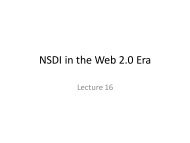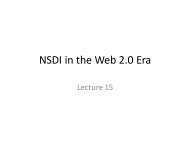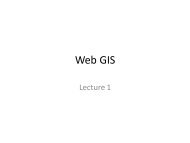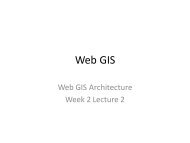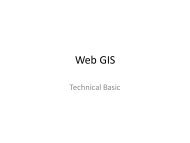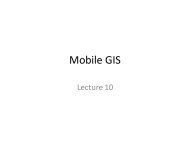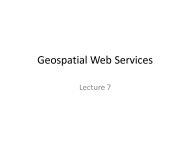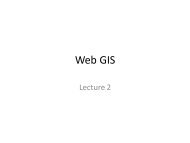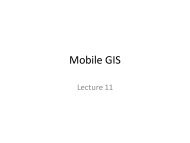4-Lecture6
Create successful ePaper yourself
Turn your PDF publications into a flip-book with our unique Google optimized e-Paper software.
Geospatial Web Services<br />
Lecture 6
Web Service Type<br />
• The communication between a web service<br />
and a client involves the client sending<br />
request to the web service, and the web<br />
service returning response to the client
Web Service Type<br />
• Depending on the format of communication<br />
used, the web service can be categorized into<br />
two main types<br />
– SOAP-based web services<br />
– REST-style web services
SOAP based web services<br />
• SOAP (Simple Object Access Protocol) is a<br />
protocol specification for exchanging<br />
structured information in XML format.<br />
“SOAP based web services use HTTP post to<br />
send request. The requests and responses are in<br />
SOAP encapsulated XMLs”
REST-style Web Services<br />
• REST (Representational State Transfer)<br />
“RESTful web services are web services that<br />
transmit data over HTTP without any additional<br />
messaging layer such as SOAP.”<br />
• In the most common RESTful web service<br />
architecture, the client sends all parameters in<br />
the request URL
RESTful Web Services Principles<br />
• Identification of resources through URI or<br />
URLs<br />
– Everything is a resource and ever resource gets a<br />
URI.<br />
– The resources and their URLs are organized in a<br />
hierarchy that is intuitive, predictable and easy to<br />
understand
RESTful Web Services Principles
RESTful Web Services Principles<br />
• Manipulation of resources through their<br />
representations<br />
– A resource can be returned in many formats e.g.<br />
JSON, XML, SVG<br />
– A resource can have multiple representations<br />
– RESTful web services allow clients to indicate<br />
which representation of a resource they wish to<br />
receive
RESTful Web Services Principles<br />
• REST also supports CRUD (create, read, update<br />
and delete) operations by using different HTTP<br />
methods<br />
– HTTP Post: Create a resource<br />
– HTTP Get: read a resource<br />
– HTTP Put: Update or create a resource<br />
– HTTP Delete: Delete a resource
RESTful Web Services Principles<br />
• Self descriptive representation<br />
– Each client request and server response is a<br />
message<br />
– RESTful applications expect each message to be<br />
self-descriptive
RESTful Web Services Principles<br />
• Hypermedia as the engine of application<br />
– To accomplish a mission, the client needs to<br />
navigate from resource to resource and trigger the<br />
state transfers to complete the workflow<br />
– The server should provide link information that<br />
can help the client navigate through the resources<br />
and state changes
Comparing SOAP and REST<br />
• In many cases, the simplicity and the<br />
efficiency of using REST outweighs the<br />
rigorous discipline of SOAP and the complexity<br />
in introducing SOAP-based web services
Advantages of REST over SOAP<br />
• For Producers: Lowering the cost of creating a<br />
service and lowering the overhead for hosting<br />
and supporting the service<br />
• For Users: Lowering the learning curve and<br />
reducing the time and money needed to build<br />
GIS applications<br />
• For Managers: Providing highly desirable<br />
architectural properties such as scalability,<br />
performance, reliability and extensibility





